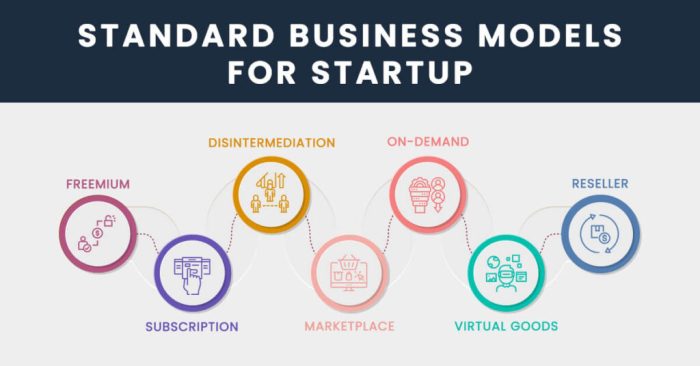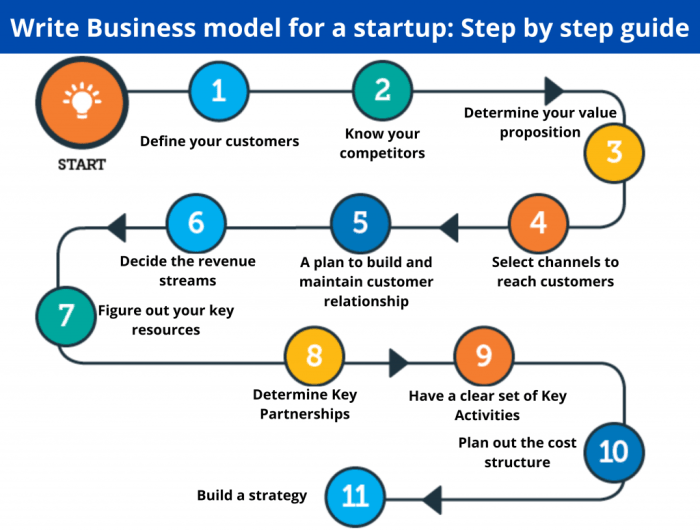Exploring Startup Business Models: A Comprehensive Guide
Embark on a journey through the intricate world of startup business models, where innovation and strategy intersect to shape the future of entrepreneurship. This introduction sets the stage for a deep dive into the various facets of creating and sustaining a successful startup in today's competitive landscape.
In the following paragraphs, we will explore the types of startup business models, the essential steps in developing them, the key revenue streams, and effective customer acquisition strategies that drive growth and success.
Types of Startup Business Models

In the world of startups, there are various business models that entrepreneurs can choose from to bring their innovative ideas to life. Each type of business model comes with its own set of advantages and disadvantages, catering to different needs and goals.
Subscription-Based Business Model
A subscription-based business model involves offering products or services to customers on a recurring basis, typically through monthly or yearly subscriptions. This model provides a steady stream of revenue and fosters customer loyalty. However, it requires continuous engagement to retain customers.
- Advantages:
Stable revenue stream, predictable cash flow, and customer retention.
- Disadvantages:
High customer acquisition costs and the need for constant innovation to keep subscribers engaged.
Example: Netflix, a popular streaming service, operates on a subscription-based model.
E-Commerce Business Model
An e-commerce business model involves selling products or services online through a website or online marketplace. This model offers a wide reach and convenience for customers, but faces intense competition and the need for effective marketing strategies.
- Advantages:
Global market reach, lower operational costs compared to brick-and-mortar stores, and customer convenience.
- Disadvantages:
Intense competition, the challenge of building brand trust online, and logistical issues.
Example: Amazon, the e-commerce giant, is a successful example of this business model.
Franchise Business Model
A franchise business model involves granting individuals or groups the right to use a company's business model and brand for a fee. This model allows for rapid expansion and leverages the success of an established brand, but comes with strict operational guidelines and fees.
- Advantages:
Rapid expansion, brand recognition, and shared marketing costs.
- Disadvantages:
High initial investment, limited control over operations, and dependence on the franchisor.
Example: McDonald's, a well-known fast-food chain, operates on a franchise business model.
Developing a Startup Business Model

When embarking on the journey of developing a startup business model, there are key steps that need to be followed to ensure success. From idea generation to implementation, each stage plays a crucial role in shaping the future of the startup.
Idea Generation and Validation
To begin developing a startup business model, it is essential to start with a strong and innovative idea. This idea should address a specific problem in the market and offer a unique solution. Once the idea is generated, it is important to validate it through market research and feedback from potential customers.
This validation process helps in refining the idea and ensuring that there is a demand for the product or service.
Market Research
Conducting thorough market research is crucial for the success of a startup business model. This involves analyzing the target market, understanding customer needs and preferences, and identifying competitors. By gathering data and insights from market research, startups can make informed decisions and tailor their business model to meet the demands of the market.
Scalability and Sustainability
When designing a startup business model, it is important to consider scalability and sustainability. Scalability refers to the ability of the business to grow and expand in the future, while sustainability focuses on long-term viability and profitability. By incorporating scalability and sustainability into the business model, startups can ensure that they are well-positioned for growth and success in the long run.
Revenue Streams in Startup Business Models
Revenue streams are crucial for the success and sustainability of startup business models. These streams represent the various ways in which a startup generates income to support its operations and growth. Let's explore the different revenue streams commonly used in startup business models and how startups can diversify them for financial stability
Types of Revenue Streams
- Product Sales: Selling physical or digital products is a common revenue stream for startups. This could include unique gadgets, software applications, or subscription-based services.
- Service Fees: Charging fees for services provided, such as consulting, training, or maintenance services.
- Advertising Revenue: Generating income through advertisements on websites, social media platforms, or mobile apps.
- Licensing and Royalties: Offering licenses for intellectual property, patents, or trademarks in exchange for royalties.
- Subscription Models: Providing access to exclusive content, features, or services through subscription-based models.
Innovative Revenue Streams in Successful Startups
- Freemium Model: Offering a basic version of the product or service for free, while charging for premium features or upgrades.
- Affiliate Marketing: Earning commissions by promoting other companies' products or services through affiliate links.
- Data Monetization: Generating revenue by selling anonymized user data to third parties for research or marketing purposes.
- Crowdfunding: Raising funds from a large number of individuals through online platforms in exchange for rewards or equity.
Diversifying Revenue Streams for Financial Stability
- Target Multiple Customer Segments: Identify and cater to different customer segments with unique products or services to increase revenue streams.
- Explore New Markets: Expand into new markets or geographic regions to tap into diverse customer bases and revenue opportunities.
- Create Partnerships: Collaborate with other businesses or organizations to offer bundled services or cross-promotional opportunities.
- Develop Recurring Revenue Models: Implement subscription-based or recurring revenue models to establish predictable income streams.
Customer Acquisition Strategies for Startup Business Models
Customer acquisition is crucial for startups to attract and retain customers. Implementing different strategies can help startups reach their target audience effectively. Let's explore the role of digital marketing, social media, networking, and data analytics in optimizing customer acquisition for startups.
Role of Digital Marketing
Digital marketing plays a significant role in customer acquisition for startups. By utilizing online channels such as search engine optimization (), pay-per-click advertising (PPC), content marketing, and email marketing, startups can increase their online visibility and reach a wider audience.
- : Optimizing website content and structure to improve search engine rankings and drive organic traffic.
- PPC: Running targeted ads on search engines and social media platforms to attract potential customers.
- Content Marketing: Creating valuable and relevant content to engage with the audience and establish thought leadership.
- Email Marketing: Sending personalized emails to nurture leads and convert them into customers.
Role of Social Media and Networking
Social media platforms provide startups with an opportunity to connect with their target audience, build brand awareness, and engage with customers in real-time. Networking, both online and offline, helps startups establish relationships with industry influencers, partners, and potential customers.
- Social Media Engagement: Regularly posting content, engaging with followers, and running targeted ad campaigns on platforms like Facebook, Instagram, Twitter, and LinkedIn.
- Networking Events: Attending industry conferences, seminars, and meetups to network with potential customers and partners.
Leveraging Data Analytics
Data analytics can help startups optimize their customer acquisition strategies by providing insights into customer behavior, preferences, and trends. By analyzing data from website traffic, social media engagement, and sales conversions, startups can make informed decisions to improve their marketing efforts.
- Tracking KPIs: Monitoring key performance indicators (KPIs) such as conversion rate, customer acquisition cost (CAC), and customer lifetime value (CLV) to measure the effectiveness of marketing campaigns.
- Segmentation: Segmenting customers based on demographics, behavior, and interests to tailor marketing messages and offers for better engagement.
- A/B Testing: Experimenting with different marketing strategies, messaging, and creative elements to identify what resonates best with the target audience.
Ultimate Conclusion

In conclusion, startup business models are the blueprint for turning ideas into thriving ventures. By understanding the nuances of each model, leveraging innovative revenue streams, and implementing strategic customer acquisition tactics, entrepreneurs can navigate the challenges and seize the opportunities that come with building a startup.
FAQ Insights
What are the advantages of a subscription-based startup business model?
A subscription-based model offers recurring revenue, fosters customer loyalty, and provides a predictable income stream for startups.
How can startups diversify their revenue streams?
Startups can diversify revenue streams by offering complementary products/services, exploring new markets, or implementing a freemium model alongside existing revenue sources.
Why is scalability important in designing a startup business model?
Scalability ensures that a startup can grow efficiently without compromising quality or incurring significant costs as the business expands.




